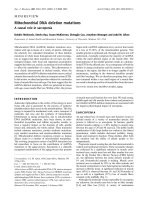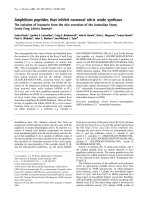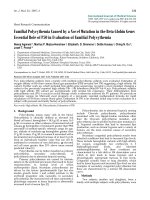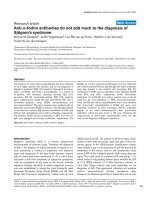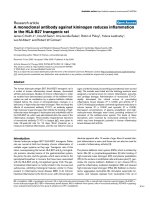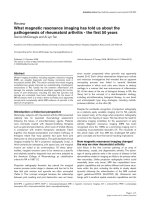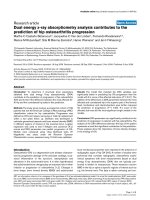Báo cáo y học: " Th2 cytokines and asthma Interleukin-4: its role in the pathogenesis of asthma, and targeting it for asthma treatment with interleukin-4 receptor antagonists" pot
Bạn đang xem bản rút gọn của tài liệu. Xem và tải ngay bản đầy đủ của tài liệu tại đây (256.96 KB, 5 trang )
FEV
1
= forced expiratory volume in 1 second; GCR = glucocorticoid receptor; IL = interleukin; IL-4R = interleukin-4 receptor; IRS = insulin receptor
substrate; rhuIL-4R = soluble recombinant human interleukin-4 receptor; Stat = signal transducer and activator of transcription; VCAM = vascular
cell adhesion molecule.
Available online />Introduction
Interleukin (IL)-4 is a key cytokine in the development of
allergic inflammation. It is associated with induction of the
ε isotype switch and secretion of IgE by B lymphocytes
[1]. IgE-mediated immune responses are further enhanced
by IL-4 through its ability to upregulate IgE receptors on
the cell surface: the low-affinity IgE receptor (FcεRII;
CD23) on B lymphocytes and mononuclear phagocytic
cells and the high-affinity IgE receptor (FcεRI) on mast
cells and basophils [2]. IgE-dependent mast cell activation
induced by IL-4 has a pivotal role in the development of
immediate allergic reactions. An additional mechanism by
which IL-4 contributes to airway obstruction in asthma is
through the induction of mucin gene expression and the
hypersecretion of mucus [3]. IL-4 increases the expression
of eotaxin and other inflammatory cytokines from fibro-
blasts that might contribute to inflammation and lung
remodelling in chronic asthma [4].
An important activity of IL-4 in promoting cellular inflamma-
tion in the asthmatic lung is the induction of vascular cell
adhesion molecule (VCAM)-1 on vascular endothelium [5].
Through the interaction of VCAM-1, IL-4 is able to direct
the migration of T lymphocytes, monocytes, basophils, and
eosinophils to inflammatory loci. In addition, IL-4 inhibits
eosinophil apoptosis and promotes eosinophilic inflamma-
tion by inducing eosinophil chemotaxis and activation
through the increased expression of eotaxin [6].
An essential biological activity of IL-4 in the development
of allergic inflammation is the ability to drive the differentia-
tion of naive T helper type 0 (T
H
0) lymphocytes into T
H
2
lymphocytes [7,8]. These T
H
2 cells are able to secrete IL-4,
IL-5, IL-9 and IL-13 but lose the ability to produce interferon-
γ [9]. Using human cells, administration of IL-4 generates
T
H
2-like lymphocyte clones, whereas incubation with anti-
IL-4 blocks this differentiation. The induction of T
H
2-like
Review
Th2 cytokines and asthma
Interleukin-4: its role in the pathogenesis of asthma, and targeting
it for asthma treatment with interleukin-4 receptor antagonists
John W Steinke and Larry Borish
University of Virginia, Charlottesville, Virginia, USA
Correspondence: Larry Borish, MD, Asthma and Allergic Disease Center, Box 801355, University of Virginia Health Systems, Charlottesville,
VA 22908, USA. Tel: +1 804 924 5917; fax: +1 804 924 5779; e-mail:
Abstract
Interleukin-4 (IL-4) mediates important pro-inflammatory functions in asthma including induction of the
IgE isotype switch, expression of vascular cell adhesion molecule-1 (VCAM-1), promotion of eosinophil
transmigration across endothelium, mucus secretion, and differentiation of T helper type 2 lymphocytes
leading to cytokine release. Asthma is a complex genetic disorder that has been linked to
polymorphisms in the IL-4 gene promoter and proteins involved in IL-4 signaling. Soluble recombinant IL-
4 receptor lacks transmembrane and cytoplasmic activating domains and can therefore sequester IL-4
without mediating cellular activation. We report the results of initial clinical trials, which demonstrate
clinical efficacy of this naturally occurring IL-4 antagonist as a therapeutic agent in asthma.
Keywords: asthma, genetics, soluble recombinant human interleukin-4 receptor, T helper lymphocytes
Received: 6 December 2000
Accepted: 8 January 2001
Published: 19 February 2001
Respir Res 2001, 2:66–70
© 2001 BioMed Central Ltd
(Print ISSN 1465-9921; Online ISSN 1465-993X)
Available online />commentary
review
reports primary research
lymphocytes is a unique biological activity of IL-4 because
IL-4 receptors and not IL-13 receptors are expressed on T
cells [10]. IgE production and the induction of VCAM-1 are
activities shared with the related cytokine IL-13.
In addition to driving the differentiation of T
H
0 lymphocytes
into the T
H
2 phenotype, IL-4 is important in allergic immune
responses owing to its ability to prevent apoptosis of T lym-
phocytes. Activation of these cells results in rapid prolifera-
tion and secretion of cytokines. In the absence of an
appropriate signal, activated T helper lymphocytes rapidly
become apoptotic and are eliminated. Several cytokines,
including IL-2, IL-4, IL-7, and IL-15, are effective in prevent-
ing the death of activated T cells. Of these, IL-4 and IL-15
are the most effective [11]. Inhibition of apoptosis by IL-4
might be mediated partly by the ability of this cytokine to
maintain levels of the survival-promoting protein Bcl-2 in T
cells [11]. Apoptosis of T lymphocytes can be induced
through signals mediated by Fas ligand through the Fas
(CD95) receptor expressed on these cells. T cells from
asthmatic lungs show defective expression of Fas. Co-cul-
turing of T cells with IL-4 downregulates Fas expression on
the cell surface. The expression of IL-4 in the asthmatic
lung and the secondary lack of Fas expression might
explain the persistence of inflammatory cellular infiltrates in
allergic asthma. Apoptosis of T
H
2 lymphocytes (and possi-
bly eosinophils) could represent a pathway by which IL-4
blockade produces rapid clinical benefits in asthma. Corti-
costeroids normally cause apoptosis in mature T helper cell
lines. Induction of cell death is prevented by IL-2 in T
H
1
cells and by IL-4 in T
H
2 cells [12]. IL-4 and IL-2 synergize
to render lymphocytes refractory to the anti-inflammatory
influences of corticosteroids. This is a result of alternative
splicing of the glucocorticoid receptor (GCR) mRNA, gen-
erating GCR-β. GCR-β is unable to bind glucocorticoids
but can bind and antagonize the transactivating activity of
the classic GCR-α. Through these mechanisms, the
autocrine production of IL-4 by T
H
2 cells in the asthmatic
lung might render these cells refractory to the beneficial
influences of corticosteroids [13]. Synergistic benefits of
interleukin-4 receptor (IL-4R) with inhaled corticosteroids
can be expected in asthmatic patients.
Clinical observations of IL-4 in allergic
disease
IL-4 is increased in the serum and bronchoalveolar lavage
of allergic individuals [14,15], and peripheral blood
mononuclear cells from atopic asthmatics increase IL-4
production in response to dust mite antigen [16]. Nebu-
lized administration of IL-4 to patients with mild asthma
resulted in a significant increase in airway hyper-
responsiveness that was associated with the elevation of
sputum eosinophil numbers [17]. A variety of findings
suggest that atopic individuals have altered regulation in
their IL-4 production. In response to bacterial antigens,
CD4
+
T cell clones from atopics produce IL-4 and IL-5,
whereas non-atopic CD4
+
T cell clones produce T
H
1
cytokines [18]. Atopic subjects have a higher frequency of
IL-4-producing T cells than do normal subjects [19], and T
cell clones generated from cord blood lymphocytes of
newborns with atopic parents produce higher IL-4 con-
centrations than neonatal lymphocytes of newborns with
non-atopic parents [20].
IL-4 genetics and asthma
Asthma has been linked to chromosome 5q31–33
through genome searches and screening of candidate
genes [21,22]. This locus includes the genes for the T
H
2
cytokines IL-4, IL-5, IL-9, and IL-13. Aberrant production of
IL-4 or hyperresponsiveness to this cytokine owing to
inherited defects might further contribute to the patho-
physiology of asthma. Optimal signaling by IL-4 (reviewed
in [23]) involves its interaction with receptors consisting of
a heterodimer of high-affinity IL-4Rα and either the
common γ chain or the IL-13 receptor α chain. Binding of
IL-4 results in the tyrosine phosphorylation of signal trans-
duction molecules including motifs similar to those
involved in insulin signaling, the insulin receptor substrate
(IRS)-1, IRS2 and signal transducer and activator of tran-
scription (Stat)-6 [23]. IRS1 and IRS2 regulate prolifera-
tion and protection from apoptosis. Stat-6 is necessary for
IL-4-dependent expression of CD23, MHC class II, ε
heavy chain, and IL-4Rα [23] and, as noted, is essential
for the differentiation of T
H
2 lymphocytes. BCL6 is a
protein that counteracts the stimulatory effects of Stat-6
by binding to Stat-6 responsive promoter elements and
repressing transcription. Through this mechanism, BCL6
has been shown to suppress IL-4-induced IgE production
[24]. Asthma has been genetically linked to polymor-
phisms in the genes encoding IL-4Rα, IL-13Rα, Stat-6,
and BCL6. A summary of the naturally occurring polymor-
phisms that are linked to atopy and asthma and might
influence IL-4 production or IL-4 signaling is given in
Table 1. Individuals genetically programmed to be hyper-
responsive to IL-4 represent a cohort of subjects who
might be therapeutically responsive to an IL-4 antagonist.
Animal studies demonstrating the role of IL-4
in asthma
Neutralizing IL-4 with anti-IL-4 antibodies in mice inhibits
the development of allergen-specific IgE [25], and reduces
eosinophilic inflammation [25] and airway reactivity [26].
These results have been confirmed by using IL-4 knockout
mice. In addition to these effects, recombinant soluble IL-4
receptor, which acts as a decoy for IL-4 binding and neu-
tralizes IL-4 activity, has been shown in murine models to
block allergen-induced airway hyperreactivity [27] and to
inhibit VCAM-1 expression, eosinophil influx, and excessive
production of mucus [28]. By inhibiting T
H
2-like lympho-
cyte differentiation and promoting the apoptosis of estab-
lished T
H
2-like cells, IL-4 blockade inhibits the biological
activities of IL-4 and, equally important, reduces the
Respiratory Research Vol 2 No 2 Steinke and Borish
production of IL-5. Nonetheless, mice deficient in IL-4 (IL-4
knockouts) maintain residual T
H
2 responses, which might
explain the persistent low-level expression of IL-5,
eosinophilia, and airway hyperreactivity observed in some
of these murine studies [10]. Although there is always a
danger in over-interpreting data derived from animal
models, these observations support the role of IL-4 in
asthma and allergic disorders.
Soluble cytokine receptors as therapeutic
agents
The IL-4R is a cell-surface, heterodimeric complex consist-
ing of a specific, high-affinity α chain (IL-4Rα) and a second
chain that can be either the common γ chain or the α chain
of the IL-13 receptor (IL-13Rα) [23]. The common γ chain is
found in multiple cytokine receptors. Although both chains
of the heterodimer are required to mediate cellular activa-
tion, only IL-4Rα is necessary for binding IL-4. Secreted
forms of IL-4Rα occur naturally and are expressed in allergic
inflammation [29]. Soluble IL-4R is capable of interacting
with IL-4 even though it lacks the transmembrane and cyto-
plasmic domains. Because it does not induce cellular acti-
vation but instead binds and sequesters IL-4, soluble IL-4R
serves as an anti-inflammatory mechanism that can counter
the effects of IL-4 (Fig. 1) and might represent an endoge-
nous autoregulatory or homeostatic mechanism. Acting as a
decoy to bind and neutralize circulating cytokine, coupled
with the high specificity and high affinity of binding for the
cytokine, makes the soluble receptor ideal as a cytokine
antagonist. Soluble recombinant human IL-4 receptor
(rhuIL-4R; Nuvance™; Immunex) is the extracellular portion
of human IL-4Rα, the gene encoding which has been
cloned and its product expressed in a mammalian expres-
sion system. Because the amino acid and carbohydrate or
glycosylation sequences are identical to those of human
IL-4R, soluble receptors are relatively nonimmunogenic. This
is in contrast to chimerized or humanized monoclonal anti-
bodies, which retain some murine sequences, or IL-4
muteins that are not authentic. The soluble tumor necrosis
factor receptor, Enbrel
, has been demonstrated to be safe
and highly effective for the long-term treatment of rheuma-
toid arthritis in adults and children.
Clinical studies with rhuIL-4R (Nuvance™)
The promising results in preclinical studies led to prelimi-
nary investigations in which rhuIL-4R proved safe and
effective in the treatment of patients with asthma [30,31].
In the phase I study, subjects with mild or moderate per-
sistent asthma were withdrawn from their inhaled corticos-
teroids and randomly assigned to receive placebo or
rhuIL-4R at 0.5 or 1.5 mg by nebulizer [30]. There were no
significant adverse events related to the study drug and no
patients developed antibodies against rhuIL-4R. Pharma-
cokinetic analysis demonstrated a prolonged serum half-
life of about 5 days, suggesting that weekly therapy would
be effective. After acute discontinuation of inhaled corti-
costeroids, no subject in the rhuIL-4R 1.5 mg group with-
drew for asthma exacerbations, compared with three of
eight in the rhuIL-4R 0.5 mg group and two of eight in the
placebo group. Treatment with 1.5 mg of rhuIL-4R was
associated with significantly better forced expiratory
volume in 1 s (FEV
1
) at 2 h after treatment and on days 2,
4, and 15 (P < 0.05). Statistically significant differences in
asthma symptom score (P < 0.05) and β
2
-agonist use
(P < 0.05) were associated with treatment with rhuIL-4R.
Scores on the third section of the AQLQ (Asthma Quality
of Life Questionnaire, showing a patient’s perception of
general health and physical functioning) worsened in the
placebo group and improved in the rhuIL-4R 1.5 mg group
(P < 0.05). Methacholine testing showed decreased
sensitivity in six out of eight patients tested in the 1.5 mg
group. Exhaled nitric oxide scores were significantly
improved in patients receiving rhuIL-4R (P < 0.05), which
is consistent with an anti-inflammatory effect.
Table 1
Genes associated with IL-4 and IL-4 signaling linked to asthma and allergies
Gene Polymorphism Location Reference
Interleukin-4 promoter A→G –81 [32]
C→T –285 [32]
C→T –590 [33]
Interleukin-4 receptor, α chain Ile→Val +50 [34]
Arg→Gln +551 [35]
Ser→Pro +503 [36]
Interleukin-13 receptor, α chain A→G +1398 [37]
Stat-6 G→A +2964 (3′ UTR) [38]
BCL6 HindIII 5′ untranslated region [39]
In the phase I/II double-blind, placebo-controlled study, 62
moderate persistent asthmatic patients were randomized
to 12 weekly nebulizations of 0.75, 1.5, or 3.0 mg of rhuIL-
4R (Nuvance™) or placebo [31]. Before the study, patients
documented their dependence on inhaled corticosteroids
by an exacerbation in asthma induced by one or two 50%
reductions in inhaled corticosteroid dose at 2-week inter-
vals. After being restabilized on inhaled corticosteroids for
2 weeks, the inhaled corticosteroids were discontinued at
the time that study medication was begun. IL-4R was safe
and well tolerated. Antibodies against rhuIL-4R occurred in
one patient that were non-neutralizing and resulted in no
symptoms. Efficacy was demonstrated by a significant
decline in FEV
1
observed in the placebo group (–0.35 l;
–13% predicted) which did not occur in the 3.0 mg treat-
ment group (–0.09 l; –2% predicted; P = 0.053 over the
three-month treatment period). Daily patient-measured
morning FEV
1
also demonstrated a significant decline in
the placebo group (–0.5 l; –18% predicted) that did not
occur in the 3.0 mg treatment group (–0.1 l; P = 0.02 over
the three-month treatment period; –4% predicted). The
afternoon FEV
1
also improved at the highest dose and was
19% better than placebo. The efficacy of rhuIL-4R was
further confirmed by the absence of an increase in asthma
symptom score (a change of 0.1) in the 3.0 mg treatment
group in comparison with the placebo group (a change of
1.4 over one month; P = 0.075).
Conclusions
These studies demonstrate that IL-4R is a potentially safe
and effective new treatment for asthma without the use of
corticosteroids. Dosing once a week, with an inhaled med-
ication targeting the lungs, will probably improve patient
compliance, which is one of the greatest challenges to the
effective treatment of asthma. Inhibiting inflammation at a
key regulatory point, IL-4R might affect the long-term
disease progression in asthma. IL-4R should also be effec-
tive in patients with non-allergic forms of asthma. Although
these patients do not demonstrate allergen-specific IgE, the
presence of eosinophilic inflammation and elevated total IgE
suggests the differentiation of T
H
2-like lymphocytes, which
are responsible for the production of IL-5 and other
cytokines that promote the development of eosinophilia. On
the basis of our current knowledge of the differentiation of
IL-5-producing T
H
2-like lymphocytes, this process is IL-4-
dependent and should be susceptible to suppression by IL-
4R therapy. Other atopic disorders such as allergic rhinitis
and atopic dermatitis are thought to be mediated by IL-4
and might also respond to IL-4 blockade with IL-4R therapy.
Soluble IL-4 receptor studies are continuing and this class
of drugs represents the next generation of asthma therapy.
References
1. Coffman RL, Ohara J, Bond MW, Carty J, Zlotnik A, Paul WE: B cell
stimulatory factor-1 enhances the IgE response of lipopolysac-
charide-activated B cells. J Immunol 1986, 136:4538–4541.
Available online />commentary
review
reports primary research
Figure 1
IL-4 binding to cellular IL-4R and its inhibition by soluble IL-4R (sIL-4R). (a) IL-4 binds to cellular IL-4R, mediating cellular activation and important
pro-inflammatory functions in asthma. For clarity, only the IL-4Rα chain of the heterodimer is shown, represented by three domains: extracellular
(green), transmembrane (white) and cytoplasmic (red). It should be noted, however, that both chains of the heterodimer are required to initiate
intracellular signaling. (b) The sIL-4R consists of the extracellular portion of IL-4Rα. It retains the ability to bind IL-4 with high affinity and high
specificity and thereby functions as a decoy receptor which can sequester naturally occurring IL-4 and prevent it from activating the cell. sIL-4R
cannot activate cellular signaling; thus, it serves as an anti-inflammatory agent that can counter the effects of IL-4 in asthma.
(a) (b)
Respiratory Research Vol 2 No 2 Steinke and Borish
2. Pawankar R, Okuda M, Yssel H, Okumura K, Ra C: Nasal mast
cells in perennial allergic rhinitis exhibit increased expression
of the Fc epsilonRI, CD40L, IL-4, and IL-13, and can induce IgE
synthesis in B cells. J Clin Invest 1997, 99:1492–1499.
3. Dabbagh K, Takeyama K, Lee HM, Ueki IF, Lausier JA, Nadel JA:
IL-4 induces mucin gene expression and goblet cell metapla-
sia in vitro and in vivo. J Immunol 1999, 162:6233–6237.
4. Doucet C, Brouty-Boye D, Pottin-Clemenceau C, Jasmin C,
Canonica GW, Azzarone B: IL-4 and IL-13 specifically increase
adhesion molecule and inflammatory cytokine expression in
human lung fibroblasts. Int Immunol 1998, 10:1421–1433.
5. Moser R, Fehr J, Bruijnzeel PL: IL-4 controls the selective
endothelium-driven transmigration of eosinophils from aller-
gic individuals. J Immunol 1992, 149:1432–1438.
6. Hoontrakoon R, Kailey J, Bratton D: IL-4 and TNF-
αα
synergize to
enhance eosinophil survival [abstract]. J Allergy Clin Immunol
1999, 103:A239.
7. Hsieh CS, Heimberger AB, Gold JS, O’Garra A, Murphy KM: Dif-
ferential regulation of T helper phenotype development by
interleukins 4 and 10 in an
ααββ
T-cell-receptor transgenic
system. Proc Natl Acad Sci USA 1992, 89:6065–6069.
8. Seder RA, Paul WE, Davis MM, Fazekas de St Groth B: The pres-
ence of interleukin 4 during in vitro priming determines the
lymphokine-producing potential of CD4
+
T cells from T cell
receptor transgenic mice. J Exp Med 1992, 176:1091–1098.
9. Jutel M, Pichler WJ, Skrbic D, Urwyler A, Dahinden C, Muller UR:
Bee venom immunotherapy results in decrease of IL-4 and IL-
5 and increase of IFN-
γγ
secretion in specific allergen-stimu-
lated T cell cultures. J Immunol 1995, 154:4187–4194.
10. Kopf M, Le Gros G, Bachmann M, Lamers MC, Bluethmann H,
Kohler G: Disruption of the murine IL-4 gene blocks Th2
cytokine responses. Nature 1993, 362:245–248.
11. Vella A, Teague TK, Ihle J, Kappler J, Marrack P: Interleukin 4 (IL-
4) or IL-7 prevents death of resting T cells: Stat-6 is probably
not required for the effect of IL-4. J Exp Med 1997, 186:
325–330.
12. Xie H, Seward RJ, Huber BT: Cytokine rescue from glucocorti-
coid induced apoptosis in T cells is mediated through inhibi-
tion of I
κκ
-B
αα
. Mol Immunol 1997, 34:987–994.
13. Leung DYM, Hamid Q, Vottero A, Szefler SJ, Surs W, Minshall E,
Chrousos GP, Klemm DJ: Association of glucocorticoid insen-
sitivity with increased expression of glucocorticoid receptor
ββ
.
J Exp Med 1997, 186:1567–1574.
14. Daher S, Santos LM, Sole D, De Lima MG, Naspitz CK, Musatti
CC: Interleukin-4 and soluble CD23 serum levels in asthmatic
atopic children. J Invest Allergol Clin Immunol 1995, 5:251–254.
15. Walker C, Bauer W, Braun RK, Menz G, Braun P, Schwarz F,
Hansel TT, Villiger B: Activated T cells and cytokines in bron-
choalveolar lavages from patients with various lung diseases
associated with eosinophilia. Am J Respir Crit Care Med 1994,
150:1038–1048.
16. Leonard C, Tormey V, Burke C, Poulter LW: Allergen-induced
cytokine production in atopic disease and its relationship to
disease severity. Am J Respir Cell Mol Biol 1997, 17:368–375.
17. Shi HZ, Deng JM, Xu H, Nong ZX, Xiao CQ, Liu ZM, Qin SM,
Jiang HX, Liu GN, Chen YQ: Effect of inhaled interleukin-4 on
airway hyperreactivity in asthmatics. Am J Respir Crit Care
Med 1998, 157:1818–1821.
18. Parronchi P, De Carli M, Manetti R, Simonelli C, Piccinni MP,
Macchia D, Maggi E, Del Prete G, Ricci M, Romagnani S: Aber-
rant interleukin (IL)-4 and IL-5 production in vitro by CD4
+
helper T cells from atopic subjects. Eur J Immunol 1992, 22:
1615–1620.
19. Chan SC, Brown MA, Willcox TM, Li SH, Stevens SR, Tara D,
Hanifin JM: Abnormal IL-4 gene expression by atopic dermati-
tis T lymphocytes is reflected in altered nuclear protein inter-
actions with IL-4 transcriptional regulatory element. J Invest
Dermatol 1996, 106:1131–1136.
20. Piccinni MP, Beloni L, Giannarini L, Livi C, Scarselli G, Romagnani
S, Maggi E: Abnormal production of T helper 2 cytokines inter-
leukin-4 and interleukin-5 by T cells from newborns with
atopic parents. Eur J Immunol 1996, 26:2293–2298.
21. Marsh DG, Neely JD, Breazeale DR, Ghosh B, Freidhoff LR,
Ehrlich-Kautzky E, Schou C, Krishnaswamy G, Beaty TH: Linkage
analysis of IL4 and other chromosome 5q31.1 markers and
total serum immunoglobulin E concentrations. Science 1994,
264:1152–1156.
22. Rosenwasser LJ, Borish L: Genetics of atopy and asthma: the
rationale behind promoter-based candidate gene studies (IL-4
and IL-10). Am J Respir Crit Care Med 1997, 156:S152–155.
23. Jiang H, Harris MB, Rothman P: IL-4/IL-13 signaling beyond
JAK/STAT. J Allergy Clin Immunol 2000, 105:1063–1070.
24. Harris M, Chang CC, Berton M, Danial N, Zhang J, Kuehner D, Ye
BH, Cattoretti GM, Kvatyuk GM, Pandolfi PP, Dalla-Favera R,
Rothman P: Transcriptional repression of Stat-6-dependent IL-
4 induced genes by BCL6: specific regulation of I
εε
transcript
expression. Mol Cell Biol 1999, 19:7264–7275.
25. Coyle AJ, Le Gros G, Bertrand C, Tsuyuki S, Heusser CH, Kopf
M, Anderson GP: Interleukin-4 is required for the induction of
lung Th2 mucosal immunity. Am J Respir Cell Mol Biol 1995,
13:54–59.
26. Corry DB, Folkesson HG, Warnock ML, Erle DJ, Matthay MA,
Wiener-Kronish JP, Locksley RM: Interleukin 4, but not inter-
leukin 5 or eosinophils, is required in a murine model of acute
airway hyperreactivity. J Exp Med 1996, 183:109–117.
27. Renz H, Bradley K, Enssle K, Loader JE, Larsen GL, Gelfand EW:
Prevention of the development of immediate hypersensitivity
and airway hyperresponsiveness following in vivo treatment
with soluble IL-4 receptor. Int Arch Allergy Immunol 1996, 109:
167–176.
28. Henderson W, Chi E, Maliszweski C: Soluble interleukin-4 recep-
tor inhibits airway inflammation following allergen challenge in
a mouse model of asthma. J Immunol 2000, 164:1086–1095.
29. Benson M, Strannegard IL, Wennergren G, Strannegard O:
Cytokines in nasal fluids from school children with seasonal
allergic rhinitis. Pediatric Allergy Immunol 1997, 8:143–149.
30. Borish L, Nelson H, Lanz M, Claussen L, Whitmore J, Agosti J,
Garrison L: Recombinant human interleukin-4 receptor in
moderate astopic asthma: a randomized double-blind,
placebo-controlled pilot study. Am J Respir Crit Care Med
1999, 160:1816–1823.
31. Borish L, Nelson H, Corren J, Bensch G, Busse W, Whitmore J,
Agosti J: Phase I/II study of recombinant interleukin-4 recep-
tor (IL-4R) in adult patients with moderate asthma [abstract].
J Allergy Clin Immunol 2000, 105:A828
32. Song Z, Casolaro V, Chen R, Georas SN, Monos D, Ono SJ:
Polymorphic nucleotides within the human IL-4 promoter that
mediate overexpression of the gene. J Immunol 1996, 156:
424–429.
33. Burchard EG, Silverman EK, Rosenwasser LJ, Borish L, Yandava
C, Pillari A, Weiss ST, Hasday J, Lilly CM, Ford JG, Drazen JM:
Association between a sequence variant in the IL-4 gene pro-
moter and FEV
1
in asthma. Am J Respir Crit Care Med 1999,
160:919–922.
34. Mitsuyasu H, Izuhara K, Mao XQ, Gao PS, Arinobu Y, Enomoto T,
Kawai M, Sasaki S, Dake Y, Hamasaki N, Shirakawa T, Hopkin JM:
Ile50Val variant of IL4R
αα
upregulates IgE synthesis and asso-
ciates with atopic asthma. Nat Genet 1998, 19:119–120.
35. Hershey GKK, Friedrich MF, Esswein LA, Thomas ML, Chatila TA:
The association of atopy with a gain-of-function mutation in
the
αα
subunit of the interleukin-4 receptor. New Engl J Med
1997, 337:1720–1725.
36. Kruse S, Japha T, Tedner M, Sparholt SH, Forster J, Kuehr J,
Deichmann KA: The polymorphisms S503P and Q576R in the
interleukin-4 receptor
αα
gene are associated with atopy and
influence signal transduction. Immunology 1999, 96:365–371.
37. Heinzmann A, Mao XQ, Akaiwa M, Kreomer RT, Gao PS, Ohshima
K, Umeshita R, Abe Y, Braun S, Yamashita T, Roberts MH, Sugi-
moto R, Arima K, Arinobu Y, Yu B, Kruse S, Enomoto T, Dake Y,
Kawai M, Shimazu S, Sasaki S, Adra CN, Kitaichi M, Inoue H,
Yamauchi K, Tomichi N, Kurimoto F, Hamasaki N, Hopkin JM,
Izuhara K, Shirakawa T, Deichmann KA: Genetic variants of IL-13
signaling and human asthma and atopy. Hum Mol Genet 2000,
9:549–559.
38. Gao PS, Mao XQ, Roberts MH, Arinobu Y, Akaiwa M, Enomoto T,
Dake Y, Kawai M, Sasaki S, Hamasaki N, Izubara K, Shirakawa T,
Hopkin JM: Variants of STAT-6 (signal transducer and activator
of transcription 6) in atopic asthma. J Med Genet 2000, 66:
380–382.
39. Baron BW, Billstrand C, Madronero L, McKeithan TW: HindIII
polymorphism in the BCL6 gene. Hum Mol Genet 1993, 9:
1513.
